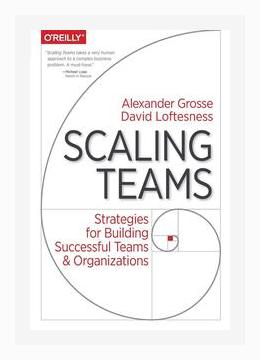Entrepreneurship and StartupsScaling Up
Scaling Teams: Strategies for Building Successful Teams and Organizations
Authors: Alexander Grosse, David Loftesness
Published: 2017
Categories: Scaling Up
Introduction
Scaling Teams by Alexander Grosse and David Loftesness is a comprehensive examination of the strategies and tactics necessary to grow and manage engineering teams effectively. The book is divided into several key areas: Structural Design, Hiring Strategies, Onboarding, Communication Practices, and Organizational Culture. Each chapter provides in-depth discussions, practical advice, and real-world examples from leading companies like Twitter, SoundCloud, and others.
1. Structural Design
Major Points:
– Team Structures: Different structures like feature teams, component teams, and matrices are discussed.
– Scaling Challenges: Moving from small, closely-knit teams to larger, more distributed ones requires deliberate structural adjustments.
Examples:
– SoundCloud: Adopted a feature team model with cross-functional members to manage their growing demands.
Actions:
– Evaluate Team Structures: Consider if your current team structure matches the evolving needs of the organization.
– Experiment: As your team expands, test different team structures on smaller scales (e.g., creating a temporary feature team) before fully implementing them.
2. Hiring Strategies
Major Points:
– Defining Roles: Clarity in role definitions is crucial for effective hiring.
– Building a Pipeline: Establishing a continuous pipeline of talent is necessary for scaling.
– Cultural Fit: Prioritizing cultural fit alongside technical skills.
Examples:
– Twitter: Used a deliberate and exhaustive interview process to ensure new hires were both technically proficient and a good cultural fit.
Actions:
– Craft Specific Job Descriptions: Ensure your job descriptions are specific and detailed to attract the right candidates.
– Develop a Referral Program: Encourage current employees to refer potential candidates who might fit both technically and culturally.
3. Onboarding
Major Points:
– Formal Onboarding Programs: Standardizing the onboarding process to solidify new hires’ understanding of company goals and expectations.
– Mentorship: Assigning mentors to new hires to ease transition.
Examples:
– SoundCloud: Implemented a structured onboarding process that included formal training sessions and assigned mentors to each new hire.
Actions:
– Create a Checklist: Develop a standardized onboarding checklist that includes all necessary training, documentation, and initial projects.
– Assign a Mentor: Pair new hires with a seasoned team member who can provide guidance and serve as a point of contact.
4. Communication Practices
Major Points:
– Channels of Communication: Utilizing suitable communication tools and channels for different types of information.
– Regular Updates: Ensuring consistent and clear updates between different levels of the organization.
– Feedback Mechanisms: Establishing mechanisms for real-time feedback.
Examples:
– Google: Uses a variety of communication tools for different purposes (e.g., Google Chat for quick questions, Email for formal communication, video conferences for meetings).
Actions:
– Audit Communication Tools: Evaluate the current communication tools being used and ensure they are serving their intended purposes effectively.
– Set Up Regular Updates: Implement regular check-ins and updates (e.g., weekly team meetings, monthly all-hands, quarterly reviews).
5. Organizational Culture
Major Points:
– Values and Principles: Clearly defined values and principles act as the foundation of a healthy organizational culture.
– Maintaining Culture at Scale: As the organization grows, maintaining the original culture requires proactive effort.
Examples:
– Zappos: Known for their strong culture, they take extraordinary steps to ensure that new hires fit the cultural mold, including offering them money to quit if the fit isn’t right after the initial training period.
Actions:
– Define Core Values: Clearly articulate and document the core values and principles of your organization.
– Cultural Assimilation Programs: Develop programs aimed at teaching and reinforcing these values to new hires.
6. Metrics and KPIs
Major Points:
– Tracking Performance: Importance of monitoring key performance indicators (KPIs) to assess the effectiveness of teams.
– Iterative Improvement: Using metrics for continual improvement.
Examples:
– Facebook: Regularly measures performance using specific KPIs tied to their goals and adjusts their strategies accordingly.
Actions:
– Identify Key Metrics: Define what success looks like for your team and identify specific KPIs to measure.
– Regular Reviews: Conduct regular performance reviews and adjust strategies based on the data collected.
7. Decision Making
Major Points:
– Decentralized Decision-Making: Empowering teams to make decisions to promote agility.
– Consensus vs. Autonomy: Balancing the need for consensus with the need for autonomous decision-making.
Examples:
– Amazon: Uses the “two-pizza team” rule to keep teams small enough to remain agile and make decisions quickly.
Actions:
– Empower Teams: Push decision-making power down to the team level whenever possible.
– Balance Input: Ensure there’s a system for both gathering input and making decisions autonomously.
8. Scaling Engineering Infrastructure
Major Points:
– Automation: Emphasizing the need to automate repetitive tasks.
– Scalable Systems: Building systems with scalability in mind from the outset.
Examples:
– Uber: Invested heavily in automating their deployment pipeline to handle their rapid scaling.
Actions:
– Automate Repetitive Tasks: Identify tasks that can be automated and implement automation tools.
– Scalability Audits: Regularly review your systems to ensure they can handle growth.
9. Leadership and Management
Major Points:
– Leadership Styles: Different situations require different leadership styles.
– Coaching and Development: Focus on leaders as coaches rather than just managers.
Examples:
– Facebook: Prioritizes leadership development programs to ensure their managers are also effective coaches.
Actions:
– Leadership Training: Invest in leadership training programs that focus on coaching and development.
– Adapt Leadership Styles: Train leaders to adapt their style based on the situational needs of their teams.
Conclusion
Scaling Teams offers a structured approach to addressing the myriad challenges that come with growing and managing engineering teams efficiently. With practical examples from industry leaders and actionable advice, the book serves as an essential guide for anyone looking to build high-performing, scalable teams.
By following the structured insights provided—from refining team structures, optimizing hiring processes, formalizing onboarding, to maintaining robust communication and culture—organizations can navigate the complexities of scaling effectively while maintaining the agility and innovation necessary for long-term success.
